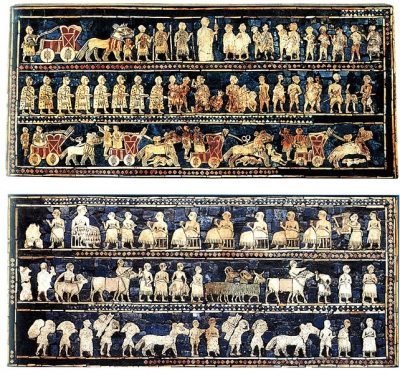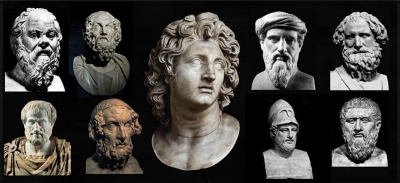Who created the world first Civilizations?

FIRST CIVILIZATIONS
More than 5,000 years ago, farming peoples in the river valleys of Mesopotamia (modern-day Iraq), Egypt, and India, created the world’s first civilizations. In Sumer, southern Mesopotamia, people known as Sumerians built the first cities. Each city was ruled by a king, who governed on behalf of the local god. This scene shows the king of the city of Ur receiving goods from his people.
King: Sumerians believed that kingship was handed down from the gods. This king wears no crown, but his importance is shown by his kilt and the fact that he is larger than everyone else.
Servants: Two men move between the king and his guests, bringing food and drink. Their low status is shown by their smaller size. They would have lived in the palace or in mud-brick homes.
Nobles: These men may have been priests, relatives of the king, or wealthy landowners. They are shown sitting on chairs with delicately carved legs, evidence of luxury at the palace.
Musicians: This man is shown playing a lyre, which has a wooden sound box decorated with the head of a bull. Other instruments from the time included harps, lutes, reed pipes, and drums.
Singer: The only woman in the scene is singing with the lyre player to entertain the guests. Music and dancing played a key role in religious rituals, such as giving thanks for a good harvest.
Farmers: Although the area was hot and dry, silt from the rivers kept the soil fertile. Farmers also dug canals to divert water to their crops, which included barley, turnips, onions, and dates.
Fishermen: Rivers offered a plentiful supply of fish for all early civilizations. From the Indus in India, the Nile in Egypt, and the Euphrates and Tigris in Sumer, fish were caught with nets or spears.
Animals: Sheep, goats, cattle, and pigs were vital to the first civilizations. They provided meat, milk, leather, and wool. Oxen were used to pull ploughs and donkeys were used for transport.
Workers: This man carries a bundle on his back, the heavy load strapped to his head. It was thanks to the toil of workers like this that massive temples for the gods could be built.
Clothing: Made from either wool or flax, both men and women wore tufted kilts, designed to resemble sheepskins. Wealthy men and women also owned elaborate gold jewellery.
THE STANDARD OF UR
This mosaic of blue lapis lazuli, red sandstone, and white shell, was made in the city of Ur in about 2,500 BCE. It decorates one side of a small wooden box found in a royal grave. The purpose of the box is not known. This side shows a peaceful banquet, while the other side depicts scenes of war.
Picture Credit : Google



















